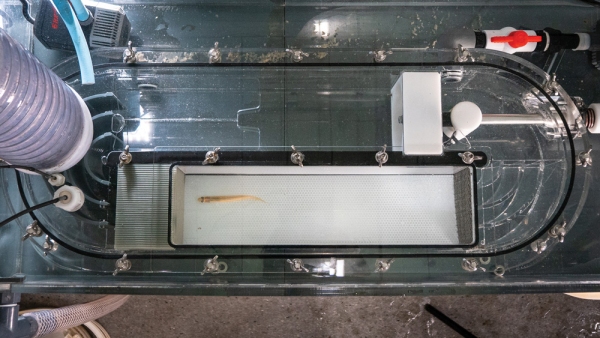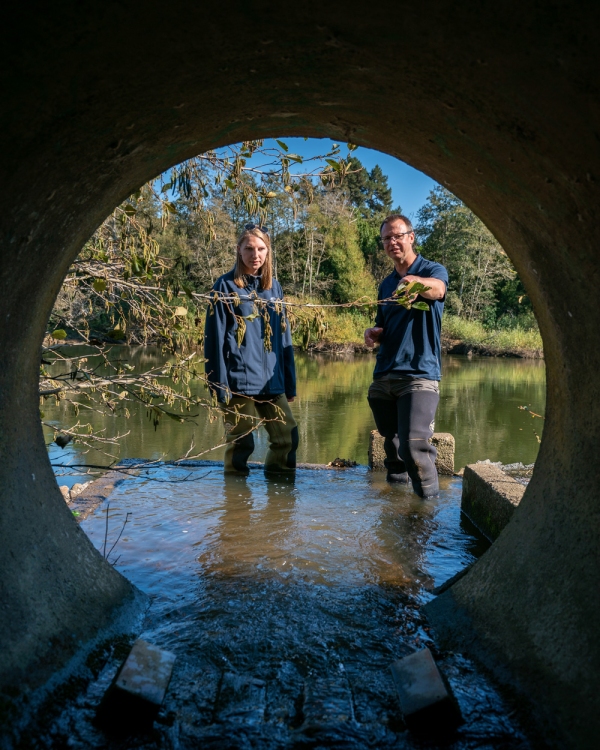Have you ever heard of a fish climbing competition? Mia Blyth drops in on the native fish getting put through their paces for a very good cause.
In a small, windowless laboratory at NIWA’s Hamilton site, you will find young native fish competing in their very own Freshwater Olympics. However, the rivalry is about far more than mere gold medal status.
Wriggling their way up steep ramps or swimming their hearts out on a specially designed treadmill, these New Zealand representatives are competing for their very survival.
There are about 50 freshwater fish species native to New Zealand. Three-quarters of these are classified as threatened with, or at risk of, extinction.
Many of our iconic natives, such as tuna and whitebait, migrate between the sea and our rivers, and, due to this transitory lifestyle, they now face imposing challenges.
As the small, finger-sized juveniles make their way upstream to reach the habitats they need to grow, feed and breed, they increasingly encounter man-made barriers such as dams, culverts and weirs.
Fragmentation of river systems is a key driver in their decline. If they can’t get past these obstacles, they are not able to access the essential habitats required to complete their life cycle.
University of Waikato PhD student Rachel Crawford is on a mission to change this.
As part of a NIWA-led, five-year Endeavour Fund project, Crawford is holding her very own piscine Olympics. She is getting the stopwatch out to see how fast individual fish can swim, and for how long, so she can help develop practical solutions to the barriers they face.
Īnanga, kōkopu, kōaro, tuna, and the common and redfin bully are among some of the species gathered from Waikato streams to take part in Crawford’s experiments. She wants to discover the top swimming speeds these small fish can sustain and how water temperature impacts on their performance.
“You can think of the experiment as like a treadmill, except this time it’s full of water, so the fish are swimming against the current, and the water velocity the fish are exposed to will gradually increase,” Crawford explains.
“This will tell us the maximum swimming velocity each fish can sustain.”
Other “competitions” measure how well fish can climb varied materials or gradients and, unbeknown to all these mini-Olympians, their performance may have a major influence on their future survival.
Crawford’s results feed directly into NIWA’s New Zealand Fish Passage Guidelines. These guidelines were used to inform new regulations in the National Policy Statement for Freshwater Management and the National Environmental Standards for Freshwater.
As a result of these regulations, any new structure which is put across a river or stream now needs to be designed to enable fish to get past, and Crawford’s work influences the designs of those fish-friendly pathways.
For freshwater ecologist Dr Paul Franklin, this work is more vital than ever. While future structures will adhere to the updated guidelines, new research shows nearly half of New Zealand’s rivers and streams are already partially or fully inaccessible to migratory fish.
New Zealand has some of the highest densities of barriers to fish passage in the world – individuals can encounter 10 or more structures on their journey upstream.
“One of our biggest challenges over the next 5–10 years is figuring out how we fix all those structures so more rivers are accessible,” says Franklin.
Thanks in part to Crawford’s “Olympics”, the good news is that solutions are now easier to implement. Old structures can be modified with well-designed fish ladders or passages.
Culverts, for example, can be fitted with ‘fish resting stops’.
“You can install baffles into culverts, which are basically panels placed inside the tube that help to slow water down and create resting areas, so that fish can pass through into the stream above,” says Franklin.
NIWA has also developed a Fish Passage Assessment Tool to provide an easy-to-use system for recording instream structures and assessing their likely impact on fish movements and river connectivity.
Anyone can use the tool and provide data by using the survey available in the NIWA Citizen Science app.
“It’s small changes like this that can make a big difference,” says Franklin.
“If we don’t start addressing the threats that we’ve placed into their environment, these precious fish will one day be gone.”
For those who are wondering: the pint-sized smelt and kōaro are currently in gold medal contention to take New Zealand’s “strongest swimmer” title.



